We’ve had friends and family come to visit over the years and we’re always looking for things to do and places to show them. So, I built a list! Most of these attractions involve history and culture that are unique to Baton Rouge. Below you’ll find a collection of my remarks, photos, and a map or two.

Back Story
As Edwin Edwards remarked about his governorships, I consider myself to be an “occasional” resident of Baton Rouge. My first stint was for about eight years during the 90’s while I earned a masters degree in landscape architecture from LSU and then began my professional career. Eventually, I met my bride and promptly drug her off to Florida because, well life’s a beach. The second, and current, tour of duty in Louisiana has been as “economic refugees” from the great recession of 2008-9 which drove my family from Florida in search of employment. We’ve now been back over eleven years. The two terms of residing here in Baton Rouge have been very different, at markedly different stages of my life. The first was as a young, single college student living close to LSU campus. The second as a husband, a father, and provider for my family, living out in the suburbs.
Cultural Interests
LSU
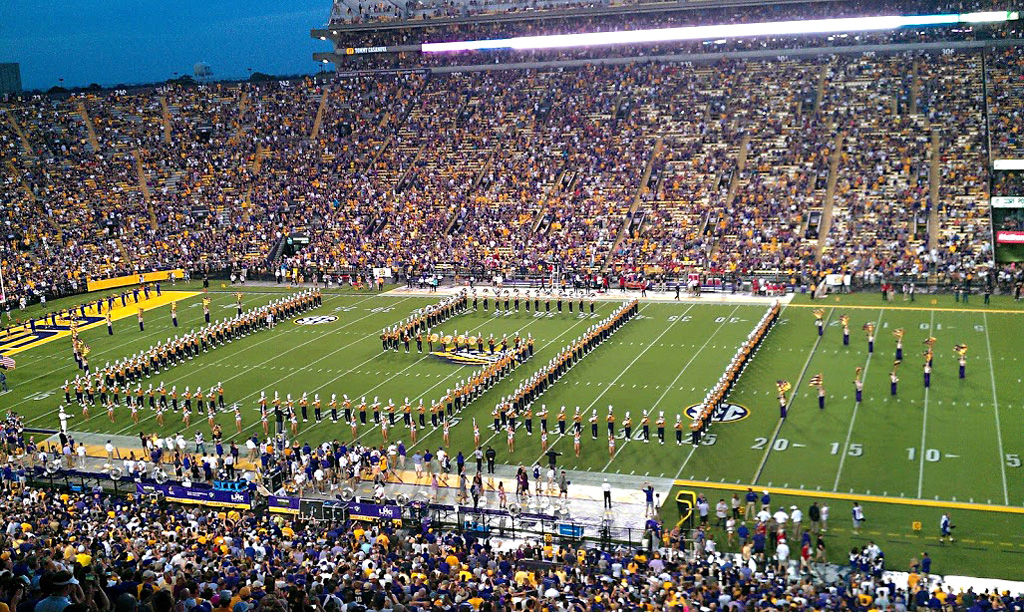 Louisiana’s largest university with its successful athletic teams is at the top of many people’s list when visiting Baton Rouge. Beyond attending an athletic event on campus you’ll want to visit:
Louisiana’s largest university with its successful athletic teams is at the top of many people’s list when visiting Baton Rouge. Beyond attending an athletic event on campus you’ll want to visit:
- Mike the Tiger in his habitat designed by Torre Design Consortium (a New Orleans landscape architectural firm specializing in zoo design.)
- Death Valley Stadium. Huge, just huge. And on Friday nights in the fall…loud!
- Memorial Tower “The Campanile”, and the parade ground at the center of campus along Highland Road.
- Hill Memorial Library offers interesting collections and historical exhibits.
- Greek row, Lakeshore Drive and University Lake.
- Museum of Natural Sciences in Foster Hall (open weekdays only)
- There’s also arts, music and theater.
The Chimes
This favorite restaurant, bar and music venue is located at the “north gates” of LSU. You can go “around the world” sampling beers at The Chimes, and enjoy seafood or “American” dishes. Baton Rouge is very much an “eat-out” kind of town and there are loads of other terrific, non-chain restaurants. There’s even a second Chimes with equally good food located out in the ‘burbs on Coursey Blvd. With so many restaurants and, really, my insufficient expertise, I’m not going to provide an authoritative list. Pick up a copy of the local “225” entertainment magazine or try Yelp or similar apps.
Three-Roll Estate (formerly Cane Land Distillery)
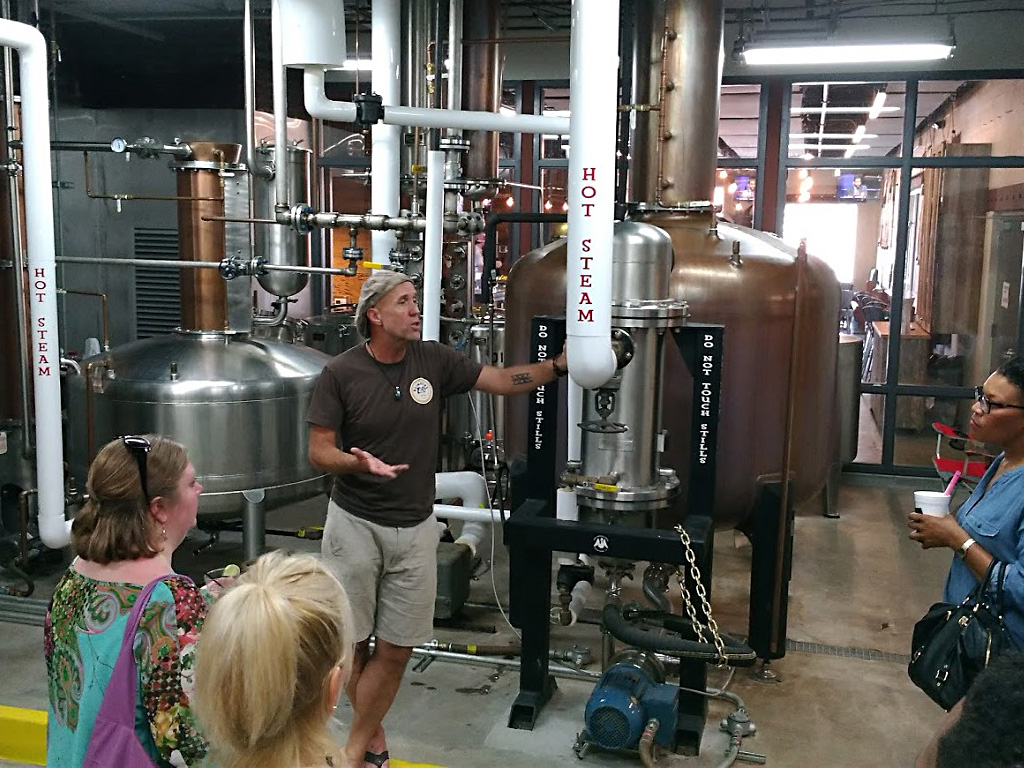 This one is for the adults and I’m going to break my own rule and give an endorsement to Cane Land Distillery located on St. Philip Street downtown. Re-branded “Three-Roll Estate” for reasons related to potential trademark conflicts with the name “Cane Land”, Three-Roll Estate bar and distillery is unique in the United States in that it is the only single-estate distillery. Three-Roll sources it’s sugarcane mash from Alma Plantation located just across the Mississippi River from Baton Rouge in Port Allen. Some of their spirits are aged in oak casks reassembled from byproducts of bourbon distilleries in Kentucky, lending flavor to the rum products. Guided tours are available (photo above.) Three Roll doesn’t yet serve food, though they do have a food truck setup next to their outdoor patio, but the smooth delicious cocktails are amazing. Farm to table never tasted so good!
This one is for the adults and I’m going to break my own rule and give an endorsement to Cane Land Distillery located on St. Philip Street downtown. Re-branded “Three-Roll Estate” for reasons related to potential trademark conflicts with the name “Cane Land”, Three-Roll Estate bar and distillery is unique in the United States in that it is the only single-estate distillery. Three-Roll sources it’s sugarcane mash from Alma Plantation located just across the Mississippi River from Baton Rouge in Port Allen. Some of their spirits are aged in oak casks reassembled from byproducts of bourbon distilleries in Kentucky, lending flavor to the rum products. Guided tours are available (photo above.) Three Roll doesn’t yet serve food, though they do have a food truck setup next to their outdoor patio, but the smooth delicious cocktails are amazing. Farm to table never tasted so good!
State Museum of Louisiana
Quite a collection of artifacts about Louisiana are displayed in this massive building located downtown on N. 4th Street. In fact, the State operates museums in Baton Rouge, New Orleans, Patterson and Natchitoches. Admission is free on the afternoons of the first Sunday of each month.
Other Museums
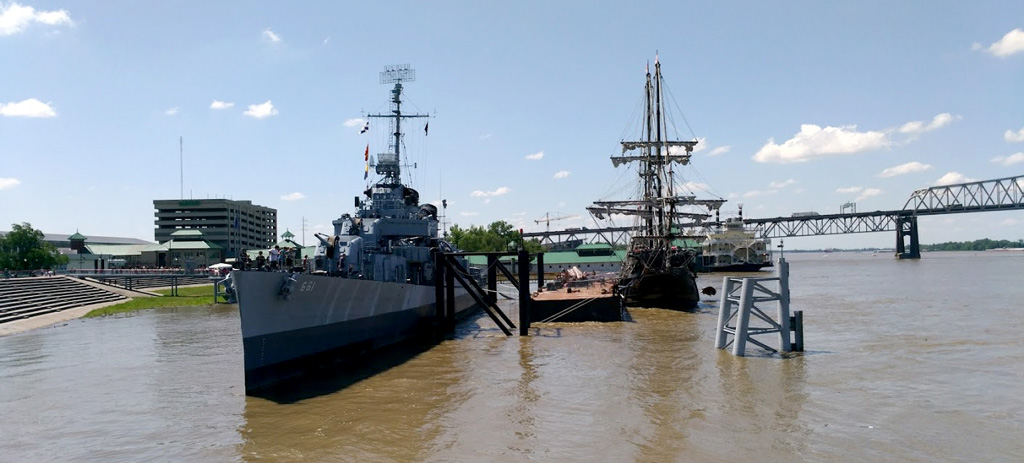 The State doesn’t have the lock on museum exhibits. Others include:
The State doesn’t have the lock on museum exhibits. Others include:
- Louisiana Arts & Science Museum in the historic Illinois Central Depot
- USS Kidd naval museum and ship
- Odell S. Williams Now And Then African-American History Museum
- BREC’s Magnolia Mound Plantation
- LSU’s Rural Life Museum
- Knock Knock Children’s Museum
- Old State Capitol and Old Governor’s Mansion have exhibits
- West Baton Rouge Museum (in Port Allen)
Historic Buildings and Sites
Baton Rouge (1805-6) is not as old as the Vieux Carre (1721) in New Orleans, but it did exist as a site of fortifications during the 1700s. It was French, then English, then Spanish, and then the West Florida Republic. Finally much of Louisiana became an American territory with the Louisiana Purchase. Most of the sites described below are near the river, and in or near downtown.
Did you know? The massive Louisiana Purchase did not include the neutral strip of western Louisiana, nor the “Florida parishes” which were British and then American territory already.
State Capitol & Grounds
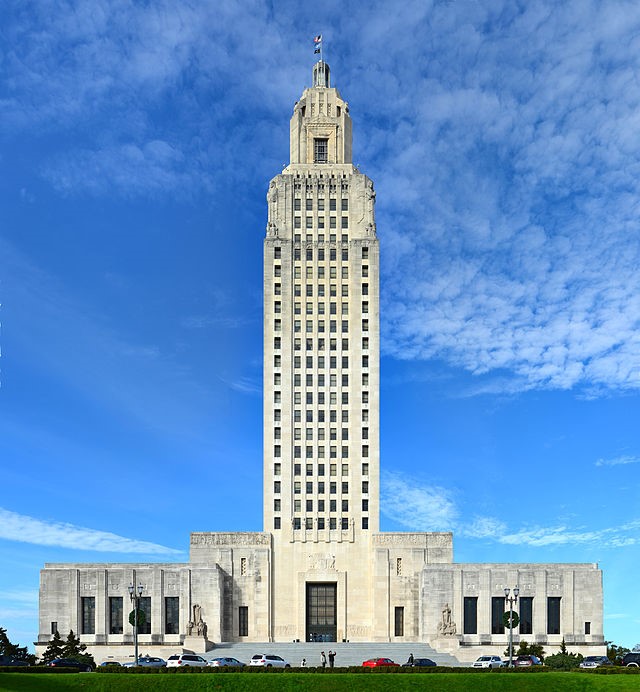 Louisiana’s state capitol was built by governor Huey P. Long intentionally to be the tallest capitol in the nation. Partly this was to satisfy his ego, but one could also argue that he wanted to create something notable - even remarkable - for all Louisianans to take pride in. Our “new” capitol is full of history. There’s a marble (granite?) column at the rear of the ground floor with an unpatched bullet hole from the shooting that occurred there. Note that Huey was a US Senator, not governor at the time. A spray of bullets littered the hallway from trigger-happy guards causing substantial damage. And, recognize that two men died as a result: Senator Long died a day later as a result of one or two wounds, but Dr. Weiss died instantly after receiving over 60 bullet wounds! Marble panels in the hallway have been relocated, repaired or replaced, but the hole in the column remains.
Louisiana’s state capitol was built by governor Huey P. Long intentionally to be the tallest capitol in the nation. Partly this was to satisfy his ego, but one could also argue that he wanted to create something notable - even remarkable - for all Louisianans to take pride in. Our “new” capitol is full of history. There’s a marble (granite?) column at the rear of the ground floor with an unpatched bullet hole from the shooting that occurred there. Note that Huey was a US Senator, not governor at the time. A spray of bullets littered the hallway from trigger-happy guards causing substantial damage. And, recognize that two men died as a result: Senator Long died a day later as a result of one or two wounds, but Dr. Weiss died instantly after receiving over 60 bullet wounds! Marble panels in the hallway have been relocated, repaired or replaced, but the hole in the column remains.
Also, in 1970 a bomb was set off in the State Senate chambers! Of course all damage has been repaired and noone was present to be injured, but a single No. 2 pencil was left stuck up into the ceiling from the blast. (Hint: Look near the only ceiling light that remains lit all the time. Binoculars help.) Try to visit the capitol on a clear weather day so you can enjoy the view from the top - the 27th floor!
It can get windy up there!
Pentagon Barracks
Initially constructed by the US Army in 1825 to house 1,000 military troops, this facility, plus nearby buildings since demolished, were the first site of Louisiana State University in 1884 when their military use was no longer needed. Today the barracks still provide housing, but for out-of-town state legislators and the office of the Lieutenant Governor. The fifth side of the pentagon has always been open, facing the Mississippi.
Old State Capitol
Louisiana’s old state capitol is a gothic temple overlooking the Mississippi River. It really shouldn’t be missed, even if all you’ve got is 10 minutes. Just walk in and look up. The spiral stair case and the stained glass ceiling above are incredible. The story of this building’s multiple deaths and resurrections are impressive as it has burned out once (1862) and fallen into abandonment as well. It is now truly spectacular.
http://www.louisianaoldstatecapitol.org/
Old Governor’s Mansion
The “Old Governor’s Mansion” is the second residence to occupy this site on North Boulevard. Huey Long used the excuse that the original “Knox Mansion” just wasn’t nice enough for his wife, so he commissioned a new (current) governor’s mansion northeast of the capitol. Visiting the current residence of the governor’s family is by invitation only, but you can tour the Old Mansion. It is set with period furnishings and objects of historic interest. The mansion is often rented out for galas, meetings, or receptions.
Spanish Town
The town’s first subdivision of 1805, is located just east of the State Capitol grounds. (I just learned this while writing this post. For decades I’d always been told that Beauregard Town was the first subdivision, but researcher John Sikes has found that Spanishtown beat it by a year.) The street grid, scale, lot size and building placement make Spanishtown a truly unique urban neighborhood, encapsulating the pedestrian-friendly characteristics that planners are now striving to re-introduce in planned communities across the nation. Want to be inspired? Look to the past. Mr. Sikes’ narrative at the link below is far more informative than what I could provide. The Spanishtown community is also regionally “infamous” for it’s annual Mardi Gras parades which tend to be, well, cutting edge. And pink…very pink.
https://www.spanishtownbr.org/about
Beauregard Town
The second subdivision of Baton Rouge (1806) was featured in an exhibit at LSU’s Hill Memorial Library during the winter of ‘19. Below is the plat and advertisement published in a New Orleans periodical by land owner Elias Beauregard, who obtained the tract as a Spanish grant.
 At the presentation I learned from librarian and exhibit producer Mark Martin that controversy surrounded these initial land offering because lots began selling before the land surveyor completed his work, so folks were showing up by riverboat in Baton Rouge with a drawing in hand and were not able to definitively see their purchase in the field. Evidently the surveyor was never paid, didn’t finish his work, and Louisiana’s very first real estate related lawsuit occurred right here in Baton Rouge. The case remained unresolved until the United States took control of the area as the Louisiana Territory at which time the suit involving a Spanish land grant was simply dropped.
At the presentation I learned from librarian and exhibit producer Mark Martin that controversy surrounded these initial land offering because lots began selling before the land surveyor completed his work, so folks were showing up by riverboat in Baton Rouge with a drawing in hand and were not able to definitively see their purchase in the field. Evidently the surveyor was never paid, didn’t finish his work, and Louisiana’s very first real estate related lawsuit occurred right here in Baton Rouge. The case remained unresolved until the United States took control of the area as the Louisiana Territory at which time the suit involving a Spanish land grant was simply dropped.
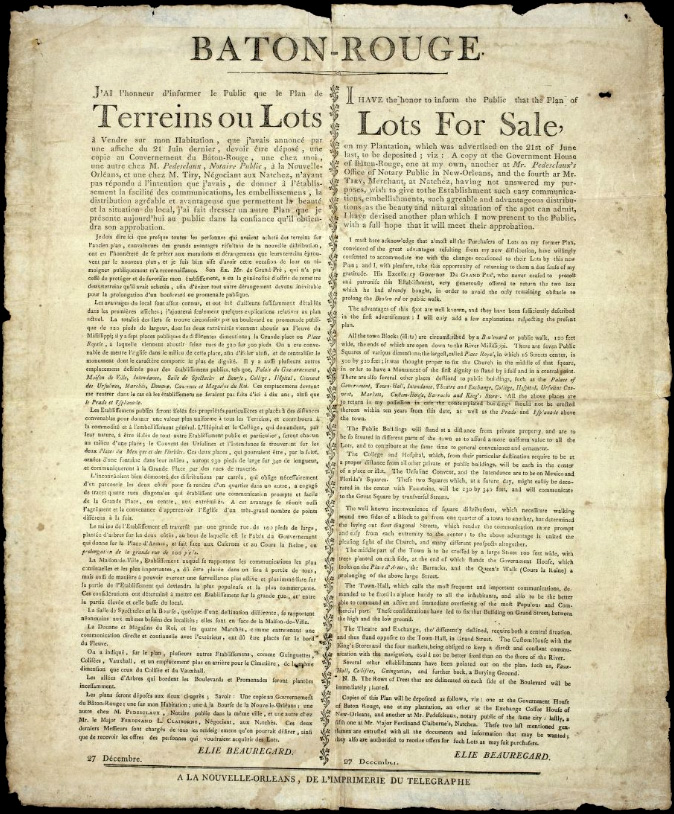 Beauregard Town was developed as a higher class neighborhood than Spanishtown to the north, and it has four diagonal streets meeting at a central square which was supposed to contain a cathedral. The opposite ends of the diagonals were each to terminate at significant public buildings at the four corners of the subdivision. Well, the central square never materialized,(it is occupied by the Bogan Fire Station and Wesley United Methodist Church,) but the diagonal streets remain a unique feature of this neighborhood, portions of which were destroyed by bombardment from river gunboats during the Civil War. An informative history of this neighborhood is here:
Beauregard Town was developed as a higher class neighborhood than Spanishtown to the north, and it has four diagonal streets meeting at a central square which was supposed to contain a cathedral. The opposite ends of the diagonals were each to terminate at significant public buildings at the four corners of the subdivision. Well, the central square never materialized,(it is occupied by the Bogan Fire Station and Wesley United Methodist Church,) but the diagonal streets remain a unique feature of this neighborhood, portions of which were destroyed by bombardment from river gunboats during the Civil War. An informative history of this neighborhood is here:
https://www.livingplaces.com/LA/East_Baton_Rouge_Parish/Baton_Rouge_City/Beauregard_Town.html
And Richard Campanella, author and geography professor at the Tulane School of Architecture, produced a video exploring the baroque origins of Beauregard Town. The video is posted on the 64 Parishes website at the link below.
https://64parishes.org/grandeur-on-government-street-video
Southern University
Admittedly I have no connection to SU, but I’ve visited the campus several times for work-related meetings and also simply sightseeing from the bluff. They’ve got some great athletics at Southern, and the marching band - the “human jukebox” - is a feast for the senses, even making two appearances in the Tournament of Roses Parade in Pasadena. For sightseeing, the SU campus (1914) sits atop Scott’s Bluff offering spectacular views of the Mississippi River as it flows around the bend to the Baton Rouge Reach. It’s an enjoyable place to rest as you sit beneath shade trees.
Parks
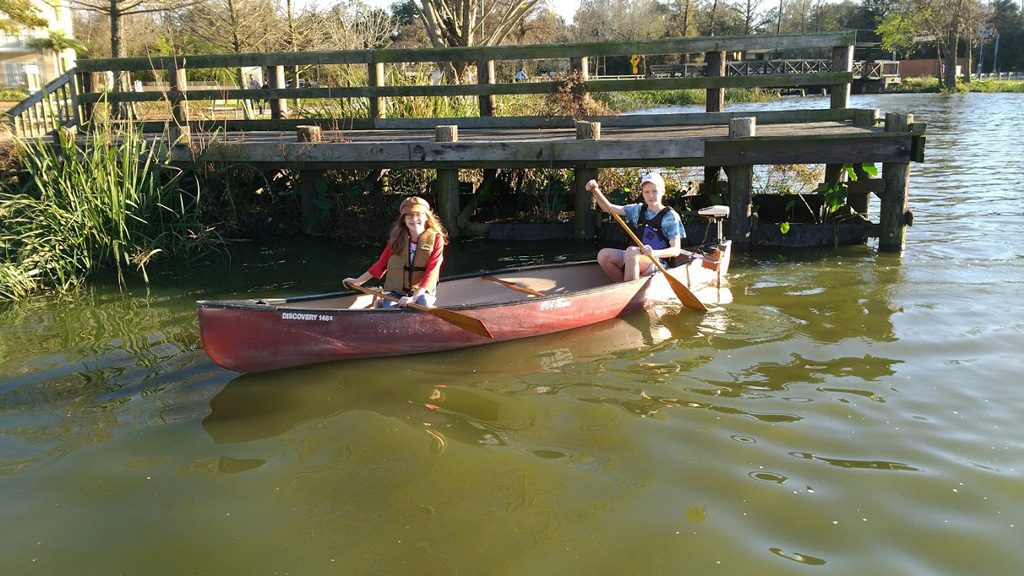 Baton Rouge is unique in the state in that the organization charged with providing parks is an entity of the State rather than of the City. BREC is charged with providing parks, recreation and habitat conservation throughout East Baton Rouge parish. Many parks have truly top-notch facilities, but of course there are others on the list for improvements. Some of my favorites are:
Baton Rouge is unique in the state in that the organization charged with providing parks is an entity of the State rather than of the City. BREC is charged with providing parks, recreation and habitat conservation throughout East Baton Rouge parish. Many parks have truly top-notch facilities, but of course there are others on the list for improvements. Some of my favorites are:
- LSU’s University Lakes and Womack Park on Stanford Avenue
- Magnolia Mound Antebellum Home
- City-Brooks Park at the north end of City Park Lake
- North Boulevard linear park
- Forest Community Park (and dog park!) on S. Harrells Ferry Rd.
- Perkins Rd. Park (active sports complex and velodrome)
- Highland Road Park, Kayak launch, astronomy observatory, and more.
- Greenwood Park and the Baton Rouge zoo are in the process of being re-imagined.
Nature Preserves
Care for a walk in the woods? Or a paddle down a bayou?
- Bluebonnet Swamp Nature Center
- Frenchtown Road Conservation Area - Amite River
- LSU’s Hilltop Arboretum on Highland Rd.
- Ducros Road Boat Launch - into Bayou Manchac (in Prairieville)
I’ve collected photos from various BREC parks and assembled them in the photo album below.
A parting shot of downtown from a plane…

